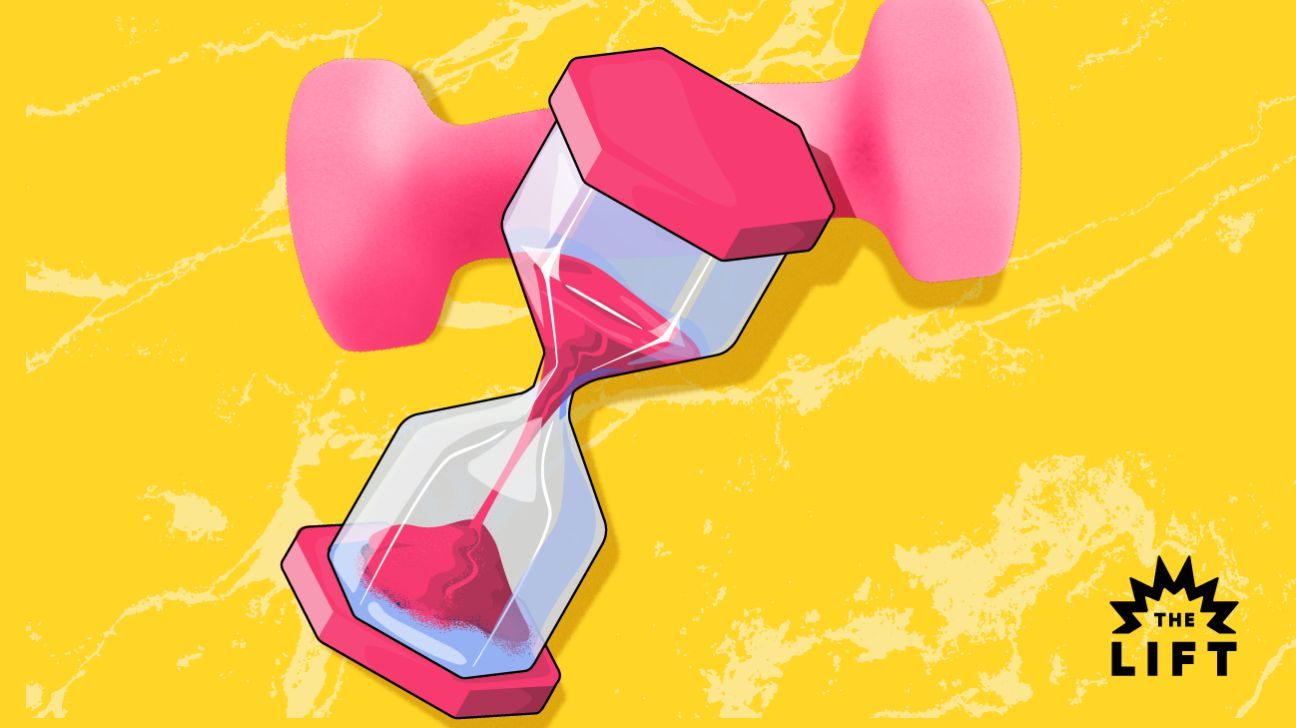
We include products we think are useful for our readers. If you buy through links on this page, we may earn a small commission. Here’s our process.
Greatist only shows you brands and products that we stand behind.
Our team thoroughly researches and evaluates the recommendations we make on our site. To establish that the product manufacturers addressed safety and efficacy standards, we:- Evaluate ingredients and composition: Do they have the potential to cause harm?
- Fact-check all health claims: Do they align with the current body of scientific evidence?
- Assess the brand: Does it operate with integrity and adhere to industry best practices?
Maybe you loathe lifting but have goals you wanna achieve. Maybe you’re worried you’re under- or overdoing it at the gym. Maybe your schedule is fuller than your Netflix queue.
Whatever your situation, you’re here because you want to know how often you need to do strength training to hit your goals.
Ahead, your answer.
Let’s get this out of the way first: Strength training zero days a week really isn’t an option. Even if you’re not interested in building a bulked-up trunk or hulk-like arms (no shade — to each fitness-er their own fitness goals), you should be strength training.
Why? Because the health benefits are LEGIT.
If you still need some convincing to get started, read on.
1. Stronger muscles, stronger heart
Whether you’re trying to run faster, hike a small mountain with a hot date, or dance for hours at the club later, strength training might just be the answer. Because yeppp, your aerobic fitness will benefit from some weight-room hangs.
Sure, lifting weights is known to build muscle and tone your physique. But, according to a 2013 research review, it can also increase your aerobic capacity — that is, it can help get blood, oxygen, and nutrients flowing to your muscles more efficiently.
In addition, strength training improves your lactic threshold.
“Lactic threshold is the amount of time it takes for your muscles to fatigue,” says Jordan Metzl, MD, a sports medicine physician and the author of Running Strong. Essentially, the higher your lactic threshold, the longer you can work out without getting tired. Go ahead and sign up for that race.
2. Injury prevention
Gaining strength also minimizes your chances of getting hurt. *Throws triumphant fist into the air*
“Strength training has been shown to increase bone density as well as increase the resilience of your tendons and ligaments,” explains Michael Boyle, a strength and conditioning coach and functional training expert in Boston. “So, not only are you simply able to lift more weight, but you’re also building resistance to injury.”
Strength training will strengthen your midline too. A strong midline = better balance. And better balance = reduced risk of falling and injuring yourself!
3. Can help with weight loss
Would your brain combust if you learned that you could hit your weight loss goals without stepping on a treadmill?
Welp, prepare for an explosion, because recent studies have shown that people who weight train can see fat and weight loss similar to those who spend the same amount of time doing cardio.
4. Improved mental health
Mental health is health! (If you read that punctuated by clap-hand emojis, you read it correctly.)
And guess what? Lifting things up and putting them back down is likely good for your mental well-being.
A 2013 study of 341 women found that participants who started strength training twice a week had better body image and began to enjoy physical activity more than before.
Also, in a small 2020 study in 24 adults, participants reported reduced anxiety symptoms after an 8-week resistance training program.
We need more and bigger studies to learn more about these mental health benefits, but the results so far are encouraging!
The short answer: 3 days per week.
Talk to almost any gym rat or trainer and they’ll tell you that’s the recommended number of times you should get your hands on some weights.
And for good reason: “When you work out 3 days a week, you’re working out often enough that you’re able to really learn the skill of lifting,” says strength coach and registered dietitian Albert Matheny, director of ARENA Innovation Corp and co-founder of SoHo Strength Lab in NYC. (Yes it is a skill!)
“Working out 3 days a week also allows you to prioritize both intensity in your workouts and recovery when you’re not exercising,” he says.
To top it off, strength training 3 days a week still allows adequate space in your schedule for other types of workouts, should that appeal to you.
Can’t make it to the weight room more than once or twice per week? That’s not bad at all!
Lifting just once a week is enough to get some benefit, according to trainers.
“I have clients who only strength train once or twice per week, and they still see some significant results in strength,” says Noam Tamir, founder of TS Fitness.
“Once per week is enough to see some results for beginners and is usually enough for more advanced athletes to maintain most of their current strength gains,” adds Matheny.
But Matheny emphasizes that if you have the option of working out 2 days a week instead of one, it’s a good idea to do that! “The difference between working out once per week and twice is significant.”
Learning new lifts will be much easier, too, if you’re going twice per week than if you’re only going once. Again, learning how to lift is half the battle for new(er) lifters.
If you’re lifting twice per week, you can bring your full oomph to each and every session. Assuming you don’t work out on 2 consecutive days, that means you’re maximizing intensity.
For people training for marathons or triathlons, adding anaerobic (strength) training 2 times per week may even be more optimal than adding more days of strength training, according to Tamir.
Why? “Because the added strength will give the body the tools it needs to handle the repetitive stress of movements like running, cycling, or swimming while still leaving time in your schedule to train,” Tamir says.
If your fitness goals are strength-specific, you may benefit from strength training more than 3 days per week.
“If you have a goal, like ‘be able to squat X within X months’ or ‘increase overall muscular hypertrophy,’ strength training more could help you reach that goal faster,” says Matheny.
However, if you’re strength training more than 2 days per week, you’re going to want to rethink what each of those workouts looks like.
“The typical rule of thumb for programming is that if you’re strength training 1 to 3 times per [week], each workout should have a full-body emphasis,” says strength and conditioning coach Jake Harcoff. “But if you’re training more frequently than that, it makes sense to start incorporating splits into your program.”
In practice, that looks like training legs on Monday, back and biceps on Tuesday, and so on.
TBH, if you’re reading this, you probably don’t need to be lifting 6 times per week.
“Strength training 6 to 7 times per week should most likely be left to the most elite lifters and longtime resistance trainers,” says Harcoff.
According to Harcoff, if you’re an average gym-goer, you’d benefit from going to the gym that often only if:
- you have only a short time to allocate to training (think: less than 30 minutes) each day
- your overall volume from the days you’re working out is low
Training this often isn’t recommended because it doesn’t give your body enough time to recover between sessions. And, as Matheny puts it, “If you’re not recovering, you’re not actually getting stronger.”
Regardless of how often you exercise, some training rules can help you reach your goals.
Do at least *some* compound exercises
What do the deadlift, squat, clean, and press have in common? They’re all compound exercises.
Compound exercises work multiple muscle groups at once and therefore offer greater bang for your buck than isolation exercises.
To understand the distinction, consider the difference between a front squat and a biceps curl. While a front squat works your calves, hamstrings, quads, glutes, core, back, forearms, and chest, the biceps curl works only your biceps.
Especially for folks who are crunched for time, compound exercises are the way to go to maximize strength (and fat burn) gains.
Boyle’s recommendation: Squeeze a variety of compound exercises that target different muscle groups (both upper and lower body) into every session.
Make do with what you’ve got
Sure, your options may be expanded if you’ve got a barbell or kettlebell handy, but it is possible to get a full-body strength workout without equipment!
If you can’t get to a gym, Boyle recommends combining movements like push-ups, pull-ups, planks, lunges, and squats.
Metzl agrees, adding that burpees, as well as plyometric jump squats and arm walkouts to push-ups, can be a nice way to switch things up. “These moves ramp up your metabolic furnace for the day,” he says.
Lift more weight
“Keep in mind the size principle: The higher the resistance, the more muscle recruitment,” says Tamir.
Meaning, you shouldn’t be reaching for the 3- or 5-pounders if you can actually lift 10 or 12 pounds with good form. The more weight you can lift safely, the more gains you’ll see.
Warm up properly
No, this isn’t just lip service — warming up actually is important.
“A proper warmup is crucial before kicking off a high resistance, high intensity workout, especially if you’re sedentary the rest of the day,” Tamir says.
Track your post-training activities too
“Proper nutrition is still king when it comes to getting the results you want,” says Matheny.
And that includes what you eat right after your workout. “Eating healthy carbs post-workout will replenish your glycogen levels and help your muscles recover faster,” Tamir says.
More important is the window for consuming protein. To maximize protein synthesis, Matheny recommends having 20 or more grams of protein within an hour of working out.
As far as strength training is concerned, doing something is better than doing nothing. The recommended frequency is 3 days per week for good gains.
Hitting the weight rack or the mat once a week may not be enough to reach your loftier goals. But any workout you do in the weight room – along with proper nutrition and hydration – is still enough to increase your overall health and fitness level.
And if you prefer to hit the gym more often, as long as you’re recovering properly, have at it!





